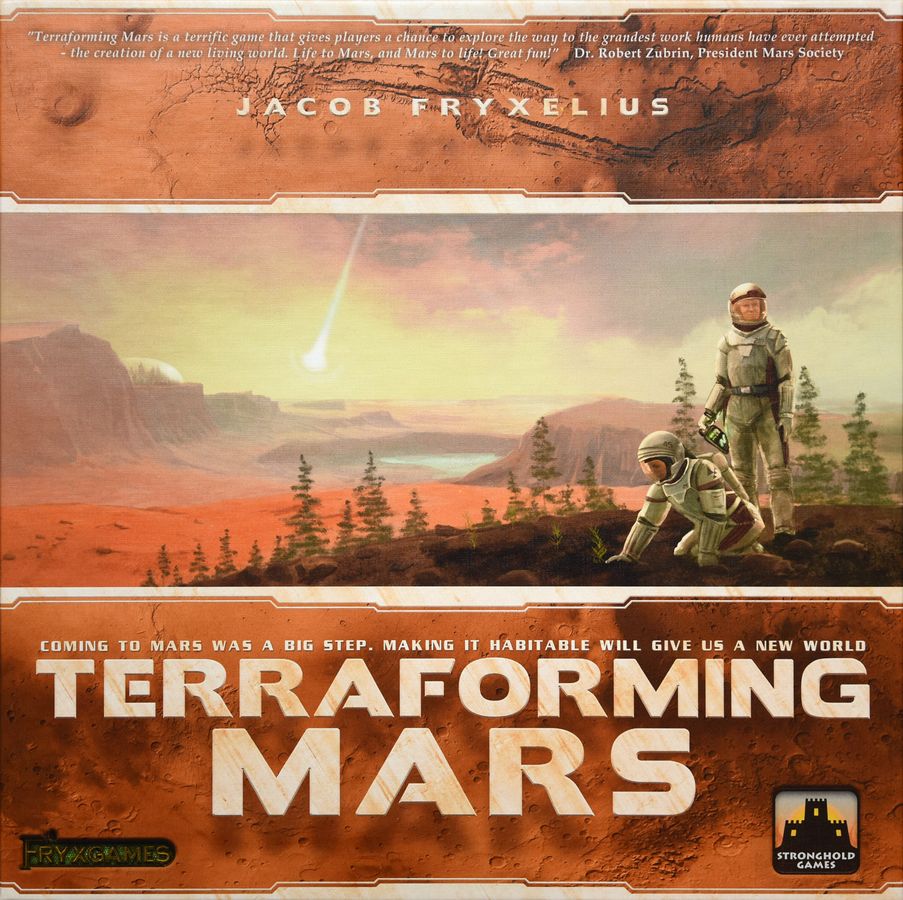Favourites from my collection
#5 Terraforming Mars
I will speak about Terraforming Mars, however, a small caveat here. I haven’t been able to meet my gaming group in getting on for a year now, and though I’ve been able to play a few games, the rankings of my games may be off. Maybe once we’re able to meet up again, I can update my rankings.
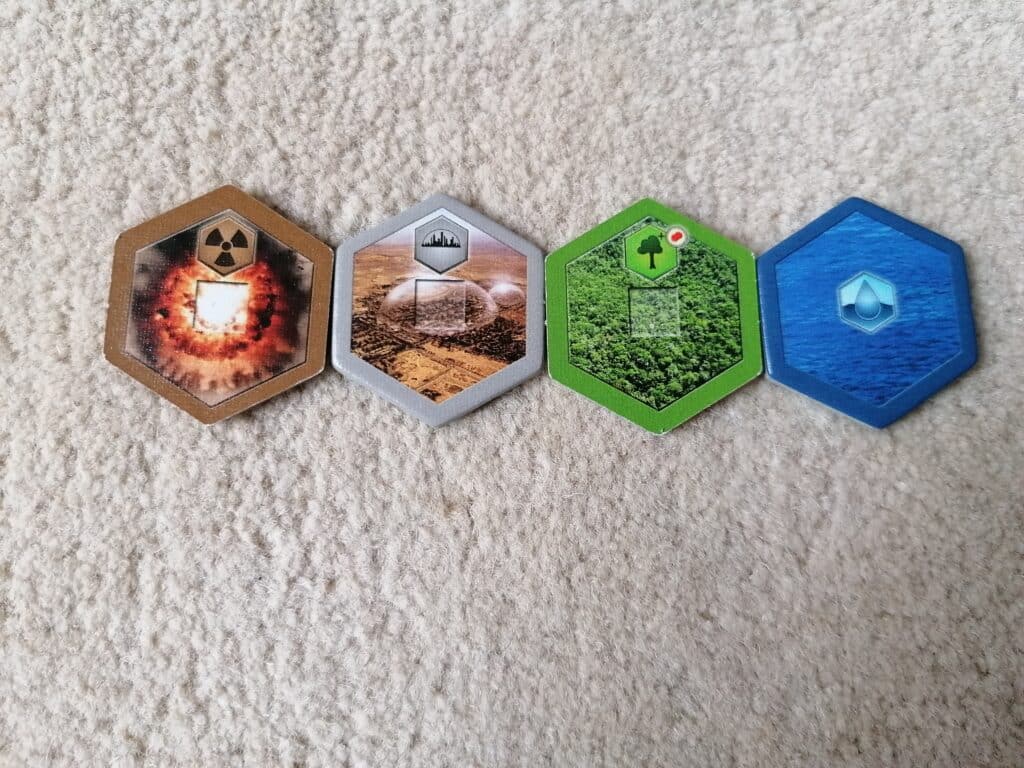
On to the actual game. Terraforming Mars. The name kind of says it all. You are competing to terraform Mars in this engine-building game, and over many generations (rounds), you will (predominantly) play cards to increase the oxygen levels, forge rivers and heat up the planet. Every time you contribute to one of these three, you’ll get a point, and once all three of these conditions are fulfilled, the game is over. You count up the points, and the person with the highest points wins.
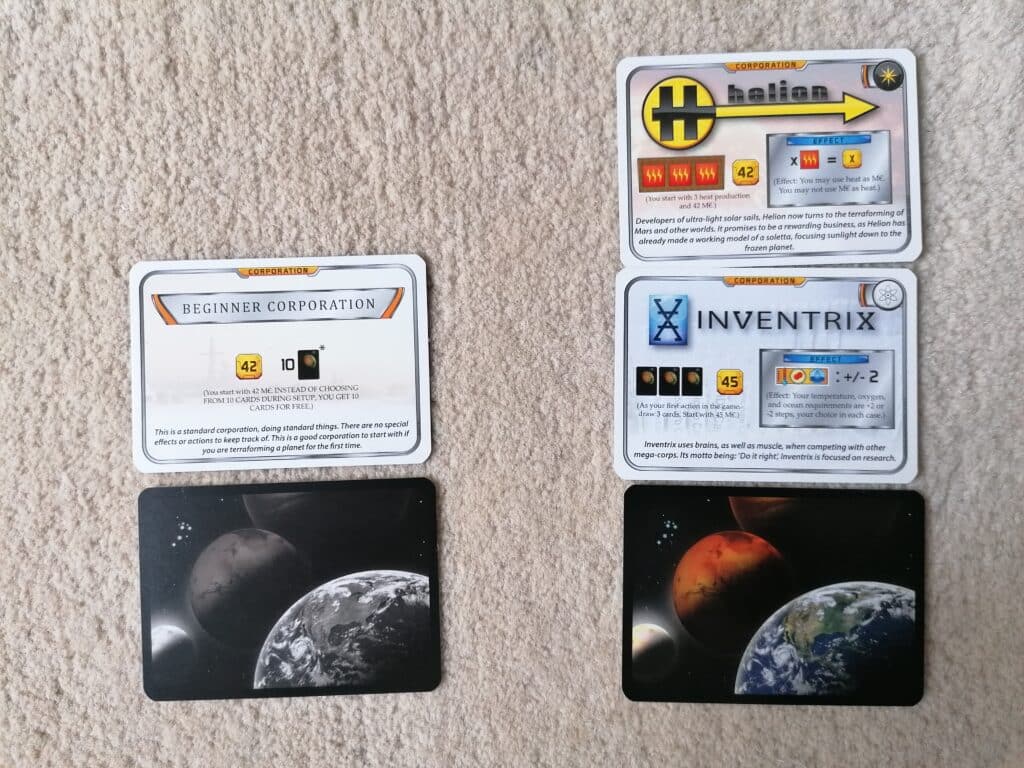
To begin the game, you’ll receive two corporations, and you’ll choose one to keep. It’s up to you whether you play with the beginner corporations, or the advanced ones. The beginner corporations are all the same; you start with 42 MegaCredits (money) and 10 cards for free. The more advanced ones are asymmetric, and some will give you ongoing effects, which are worth paying attention to. At the beginning of each round, including the first, you’ll receive new cards. With the more advanced corporations, you’ll need to pay to keep them in hand every round. From round two onwards, you’ll need to pay when using the beginner corporations.
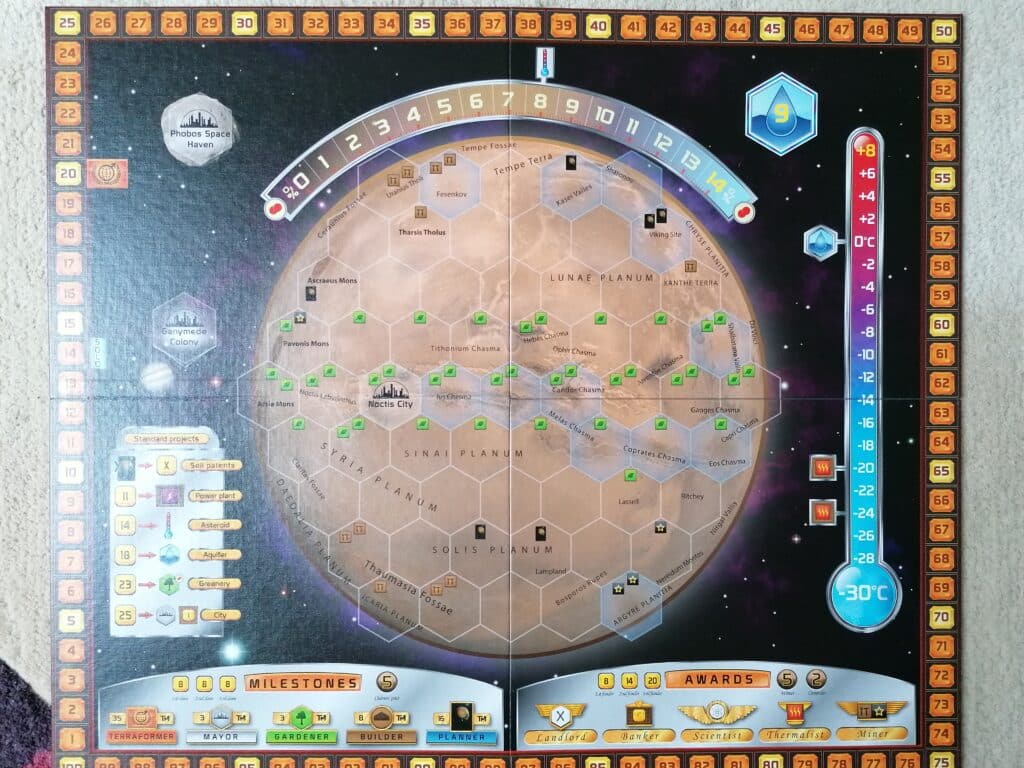
Mars is split into various hexes, and on these you’ll be placing forest tiles, city tiles and the aforementioned river tiles. Forests increase the oxygen on Mars, moving you towards the end game, but they’re also worth one point each. Cities are only worth points if they are adjacent to forests (1 point per adjacent forest), so place them too early and you risk the other players steering clear of that area, but wait too long and there may not be many space available for you to place them. This adds a small, but interesting, bit of interaction between you and your fellow players on the board itself. Rivers are limited. There are only 9 available for the game, so it’s important to try to get them out as quickly as possible. The blue hexes on the board are reserved for river tiles (though some cards can break this rule), and rivers can only go on blue hexes (again, a few cards can break this), so again, you need to choose where to place your tiles wisely. You can also see some symbols on some hexes, which means that when you place a tile there, you receive whatever is indicated (I’ll get into the symbols later).
As I mentioned, you’re going to be predominantly playing cards on your turns, but there are a few more actions available. To the left of Mars there is a ‘Standard Projects’ section, where you can sell cards from your hand you don’t want, or pay money to do various things, from raising the temperature of the planet, to placing out a city tile (and increasing your MegaCredit production by one). At the bottom of the board, there is a ‘Milestones’ section and an ‘Awards’ section. A milestone is something you have already achieved, and you use an action to buy it. Be careful though, if you wait too long to do this, someone else may achieve it and pay for it, and it’s first-come-first-served. Awards are something which you pay for during the game, and will score at the end. As an example, if you think you’ll have the highest MegaCredit production at the end of the game, you’ll use an action to buy that award, and state one of your intents for the end of the game. It’s risky though, as an opponent may decide to aim to beat you to the award, meaning that you’ve spent money to give them 5 points.
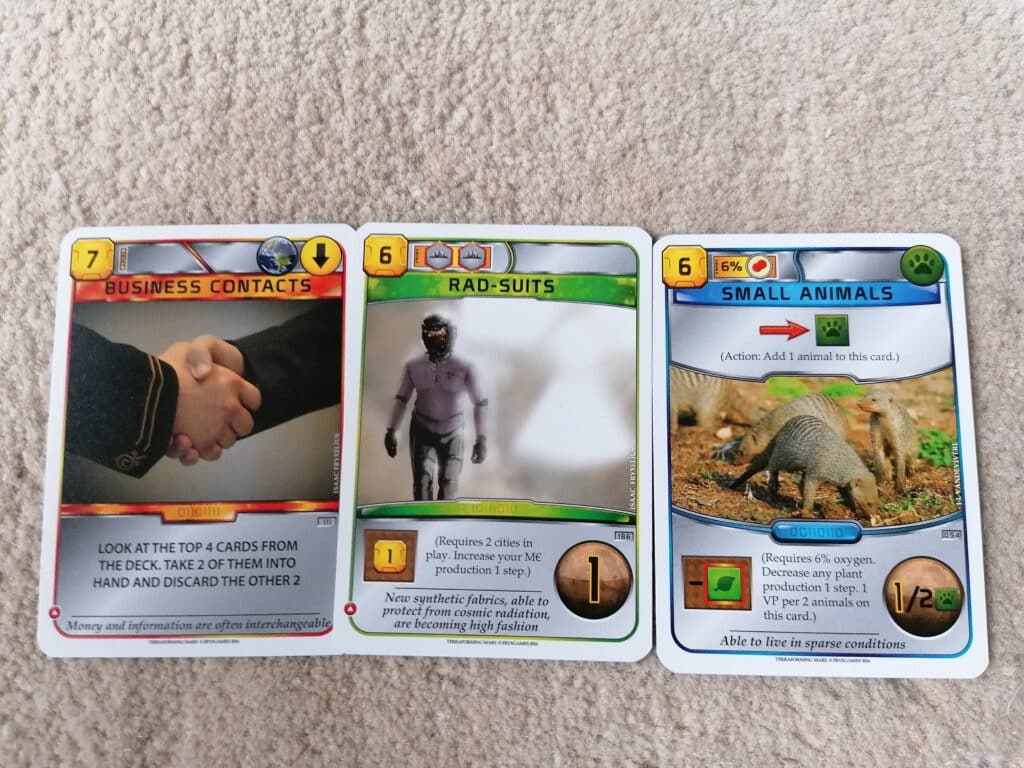
There are three types of cards in the main deck: red, green and blue. The blue cards give you more actions to do on your turn (the one pictured allows you to add an ‘animal’ (a cube) to the card), though you can only do them once per round, or ongoing effects. Red cards are usually one-and-done cards, and some allow you to steal something from an opponent. Some people don’t like this, as they don’t like to feel like they’re picking on one person, or putting a dent in their strategy. I don’t mind them, but be aware of these. The green cards usually allow you to either place more tiles on the board or increase your production of a specific resource. All cards will have a cost to play them in the top left. Next to this, some cards have prerequisites, so you may not be able to play them depending on the state of the board. In the top right of some cards are symbols, or ‘tags’, and you may need to have played a certain amount of ‘tags’ in order to do something else within the game later, most commonly play another card. Some cards also have points (positive or negative) on the bottom right.
Rounds only end when everyone around the table passes. When it comes to you, you can either take one action, take two actions, or pass. After passing, you’re not out of the round, so you could pass strategically to see what the board state will be like when it gets back to your turn, but it could be risky, as everyone else could pass too. That’s where it’s sometimes best to only do one action; one that may not be exactly what you want to do, but it’s enough to guarantee that you’ll get another turn, even if everyone else passes. These kind of decisions, while seemingly small and insignificant, could give you an edge.
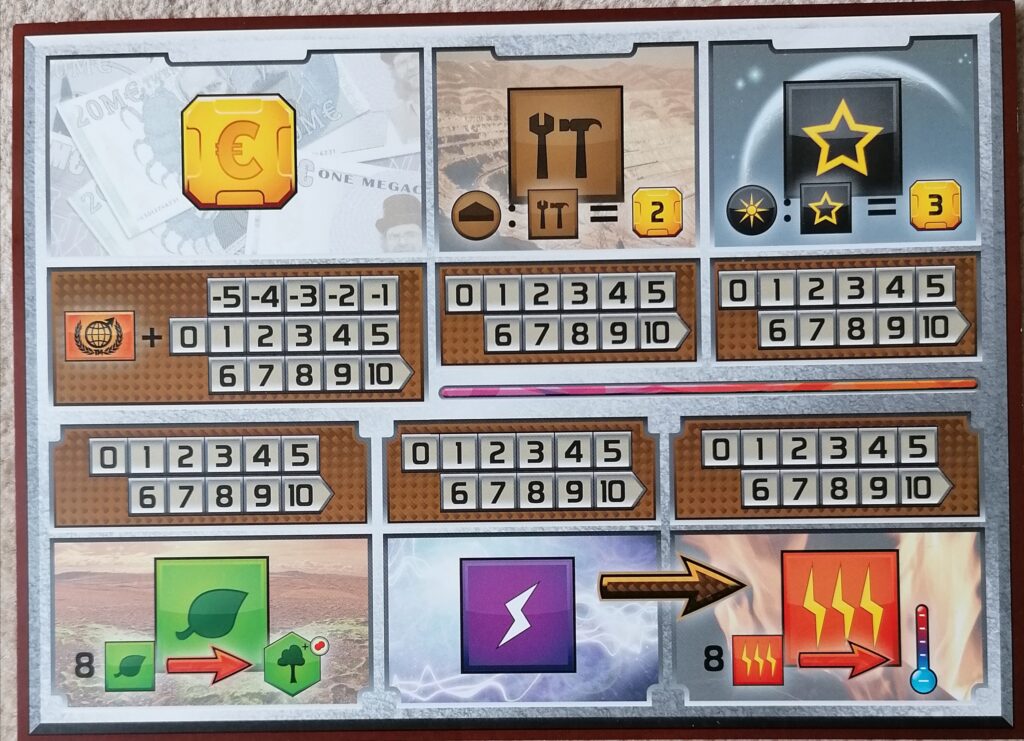
Once the round does end, we move into the production phase. Each player receives various resources based on the production levels (the numbers in the brown sections) on their player board, plus, for the MegaCredit production, your point tally is added to your production level. In a multiplayer game, everyone start the game at 20 points, so each player will get a base level of 20 MegaCredits from round two onwards. After MegaCredits, the resources (from top left to bottom right) are steel, titanium, greenery, energy and heat. Steel and titanium can be used to pay to play cards with certain tags, at the conversion rate shown, greenery can be used to place forest tiles, energy converts to heat, and heat can be used to increase the temperature of Mars. Though there are issues with the player mats (I will come to that later), I think the way the various resources interlink with the other aspects of the game, and each other, is a clever system, and works smoothly once you’ve played a game or two.
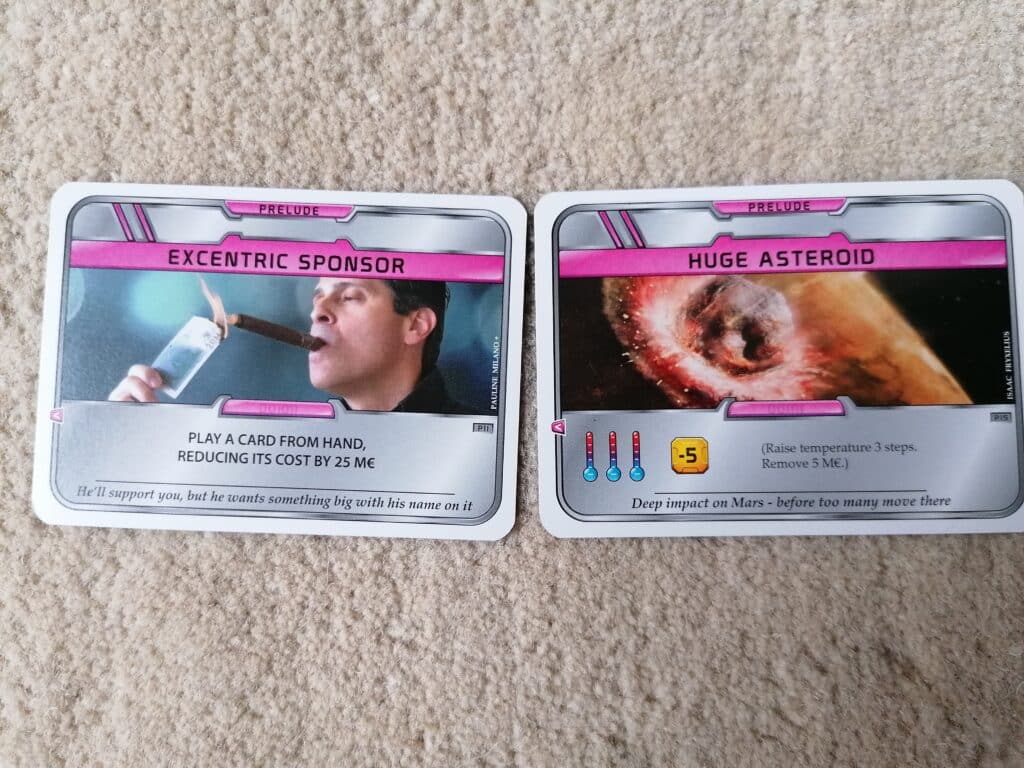
There are numerous expansions for Terraforming Mars; some are just new maps, some do a bit more. The only one I have played with, and the only one I own, is Terraforming Mars: Prelude. In terms of size, it’s a very small expansion, but in terms of what it does for the game, I think it’s huge. It adds some different corporations, which is nice, but the main addition is the ‘Prelude deck’. During setup, you’ll be dealt four prelude cards, and after choosing your corporation and cards, you’ll play two of these prelude cards in front of you, discarding the other two. In one way or another, they will let you do something which will kickstart your game, whether that’s playing an expensive card at a huge discount, increasing your production for one or more resources from the start of the game, or moving the game closer to the end, giving you points. I’ll always advise that, for at least your first game, you should try just the base game on its own, but if you find that the game is maybe a bit too long, that it takes a while to get your engine going, that you don’t have enough focus at the beginning of the game, or a combination of these reasons, then this is definitely one to try.
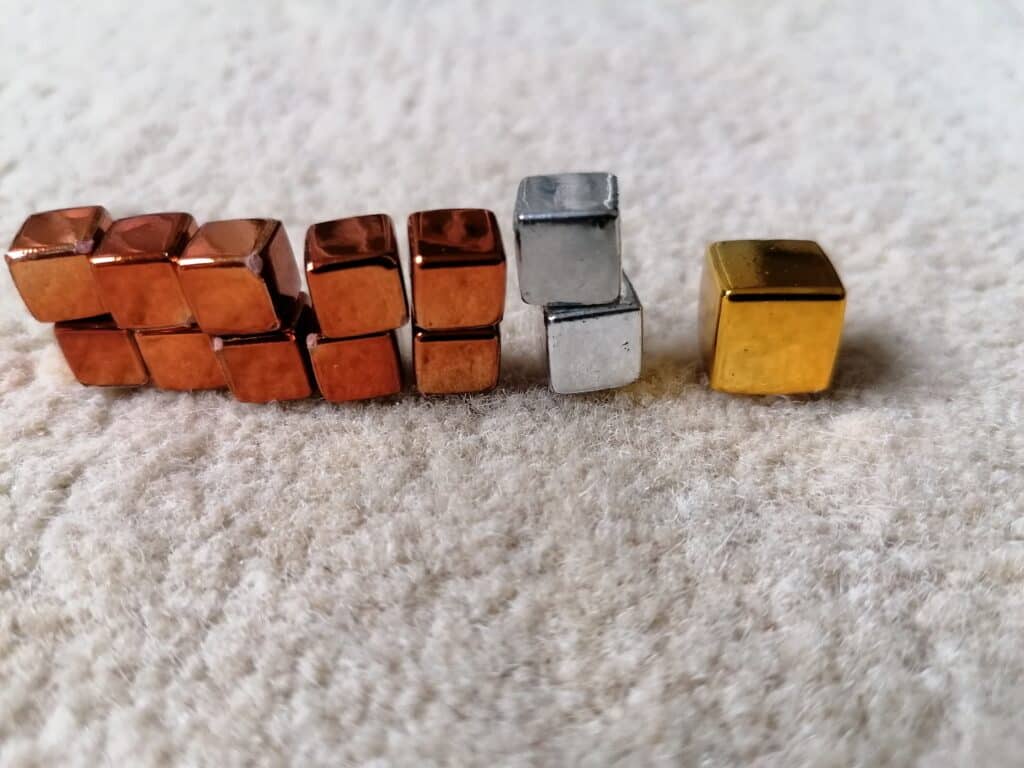
In no way do I pretend that this is a game without its faults. The production isn’t great, to put it mildly. The tiles are fairly basic, the colour on the resource cubes (bronze, silver and gold) chips and wears off fairly quickly due to players handling them a lot, and the player boards are thin and not very user friendly. To mark your production levels, you place a cube of your colour on the relevant number, but it’s very easy for the cubes to be knocked around, even with just a slight bump of the table. Another issue here is that your production is never limited, so if you get to 20+ production, you have to stack cubes on top of each other to indicate this. It’s even easier to knock those over, and it’s not easy to stack them. There are plenty of third-party accessories you can buy to fix some of these issues, but they don’t come cheaply.
The card art is questionable, with many being photographs or CGI, rather than being illustrated artwork. The game can be long if players around the table are prone to analysis paralysis, and some people don’t like the randomness of the cards. There is a variant in the rules, where rather than being dealt random cards at the beginning of a round, you draft them. This does help the issue, but adds yet more time to the game. I don’t mind a game with random card draws, as I believe that, even if you don’t get the exact cards you’re looking for in relation to strategy you have in mind, you can always change tactics, at least for one round, and make the most of them, or not use them at all and save up money, but be mindful that this is not a view everyone shares.
I can overlook these flaws to thoroughly enjoy Terraforming Mars. I love the hand-management aspects of the game. I love that, because of the huge deck of cards, you can never choose just one strategy and stick to it, you have to cleverly manoeuvre the potential obstacles in the shape of a card that doesn’t feed into what you’re building your engine towards. And I absolutely love engine-building, which may well become apparent with other games in my favourites. Building a tableau in front of you that give you more and more potential actions to take throughout the game is so enjoyable to me, and you can create a lot of good combos with them. It’s not for everyone, as no game is, but if it sounds like something that may be of interest, I implore you to look further into it and certainly check out Terraforming Mars.
| Prices delivered by BoardGamePrices | |
|---|---|
 | Terraforming Mars £50.17 with shipping, in stock! Buy now See all 54 offers! |

